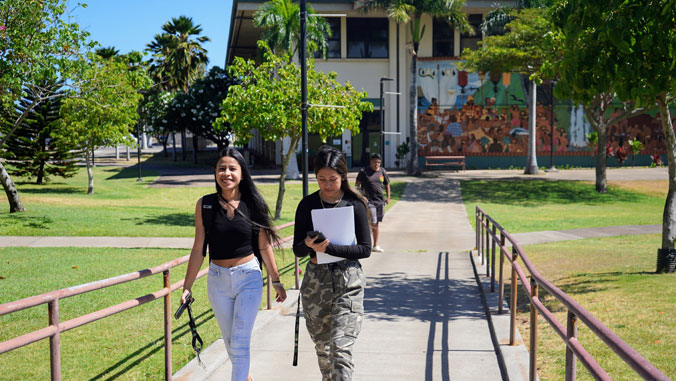
This column by University of Hawaiʻi Maui College Chancellor Lui Hokoana was published by The Maui News on August 22, 2024.
Since the Great Recession of 2008–2009, the U.S. has faced a significant shortage of qualified teachers. The situation has grown steadily more acute and was further exacerbated by the COVID-19 pandemic. Maui has not been immune. We also face a serious scarcity of new teachers, particularly Hawaiian Immersion teachers.
“We tried to think of something we could do in our capacity as a community college to provide a bridge to teacher licensure programs for people who are not able to attend college in the traditional sense,” says Kahele Dukelow, UH Maui College Vice Chancellor of Academic Affairs.
The result is the Hoapili Teacher Pathways Program which launched in Summer 2023. “We’re committed to helping those interested in becoming licensed teachers by offering a free online substitute teacher certification course, tuition-free coursework across various disciplines necessary for teacher licensure, academic advising, one-on-one student support, and professional development,” explains Hoapili Academic Support Specialist Kanoe Pacheco.
The program serves an immense range of students–new high school graduates, non-traditional students, State of Hawaiʻi Department of Education long-term substitute teachers, emergency hires, educational assistants, teacher assistants, registered behavioral technicians, librarians, parents of Hawaiian Language Immersion students, school administrators more. “As a result, we have a one-on-one approach when meeting with and advising them, offering them tailored advice, pathways, and support,” says Pacheco.
In just one year, student interest, course registration numbers, and the number of students entering licensure programs has grown exponentially. It’s a testament to the need for more programs like this which actively find solutions to close the gap for students in higher education. The program is specifically designed to make coursework accessible by being free, online, and scheduled during after-work hours.
“It has been truly amazing working with the 200+ students who actively register for our tuition-free courses each semester,” says Pacheco. “Hearing their stories and helping them work towards their goals of becoming teachers has been inspiring. Their perseverance and dedication to their dreams and betterment of their communities and families is memorable. I am privileged and honored to work with such amazing individuals.”
Maluhia Low is a Hawaiian Studies lecturer as well as a student affairs program specialist who echoes her colleague’s sentiments. “Observing the students’ hard work, determination, growth, and adaptability has been inspiring,” she says. “Seeing their dedication and progress at this stage in their journey gives me great confidence in their future as educators. Additionally, all their journeys began here on Maui. The ‘grow our own’ initiative takes on a whole new meaning when we can truly establish their roots here on Maui for Maui. I’m genuinely excited about the future of Maui’s teachers.”
Haʻikū Elementary School first grade teacher Makella Diaz is one of them. “The Hoapili Teacher Pathway program is an incredible learning opportunity,” she says. “The program offers flexible classes to accommodate working adults, making it easier to balance life’s commitments while pursuing your passion for teaching. As a full-time working wife and mother, I deeply understand the importance of finding a program supporting your busy lifestyle without compromising your educational goals. The program is more than just a pathway to becoming a teacher–it’s a journey toward becoming a community leader.”
The Hoapili Teacher Pathways Program is funded by two grants. A Hawaiʻi Department of Education grant aims to provide the shortest pathway to a Kaiapuni (Hawaiian Immersion) teacher licensure. It funds the exploration of the use of existing processes and testing of new strategies for recruiting, hiring, mentoring, and retaining new teachers for Kaiapuni classrooms.
A U.S. Department of Education Title III Programs for Alaska Native and Native Hawaiian Serving Institutions grant funds a collaboration with UH Mānoa–Native Hawaiian Student Services. A focus of this grant is to improve and expand multi-disciplinary research opportunities and engagements by and between Hawaiian students and faculty at the University of Hawaiʻi at Mānoa and Maui College, between public school educators and administrators in the Hawaiʻi Department of Education, and with Hawaiian-focused charter schools and organizations. The goal is to enhance the success of Hawaiian students by creating academic spaces that sustain and promote Hawaiian knowledge, pedagogies, and communities, fostering stronger connections between UH Mānoa and our college.
The ability to access funding will determine the project’s short-term future. “Our long-term hope,” says Pacheco, “is for projects like these to receive permanent funding by either the University of Hawaiʻi or the Hawaiʻi Department of Education or both so we can continue to train the teachers that will sustain Hawaiʻi’s future generations of students and leaders.”
For more about the Hoapili Teacher Pathway Program, please visit https://sites.google.com/hawaii.edu/uhmc-teacher-pathway-program/home For complete UH Maui College information, please visit http://maui.hawaii.edu/
*Dr. Lui K. Hokoana is Chancellor of the University of Hawaiʻi Maui College. Kaʻana Manaʻo, which means “sharing thoughts,” is scheduled to appear on the fourth Sunday of each month. It is prepared with assistance from UH Maui College staff and is intended to provide the community of Maui County information about opportunities available through the college at its Kahului campus and its education centers.

